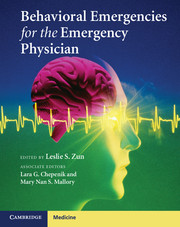Crossref Citations
This Book has been
cited by the following publications. This list is generated based on data provided by Crossref.
Somville, Francis J.
De Gucht, Véronique
and
Maes, Stan
2016.
The impact of occupational hazards and traumatic events among Belgian emergency physicians.
Scandinavian Journal of Trauma, Resuscitation and Emergency Medicine,
Vol. 24,
Issue. 1,
Munawar, Khadeeja
Bokharey, Iram Zehra
and
Choudhry, Fahad Riaz
2017.
Sexual conflicts in panic disorder: a multi-case study.
Mental Health Review Journal,
Vol. 22,
Issue. 4,
p.
300.
Hashmi, Ali M.
Czelusta, Kim-Lan
Jabbar, Qammar
Siddiqui, Samia
and
Shah, Asim A.
2018.
Psychiatric Illness in the Emergency Department.
Psychiatric Annals,
Vol. 48,
Issue. 1,
p.
21.
Shah, Asim A.
2018.
Psychiatric Emergencies.
Psychiatric Annals,
Vol. 48,
Issue. 1,
p.
18.
Curry, Ashley
and
Riddle, Megan
2021.
Behavioral Emergencies for Healthcare Providers.
p.
141.
O’Donovan, D.
Quane, T.
and
McCauley, M.
2023.
Is ‘medical clearance’ for acute general adult psychiatric presentations always necessary?.
Irish Journal of Psychological Medicine,
Vol. 40,
Issue. 2,
p.
298.





